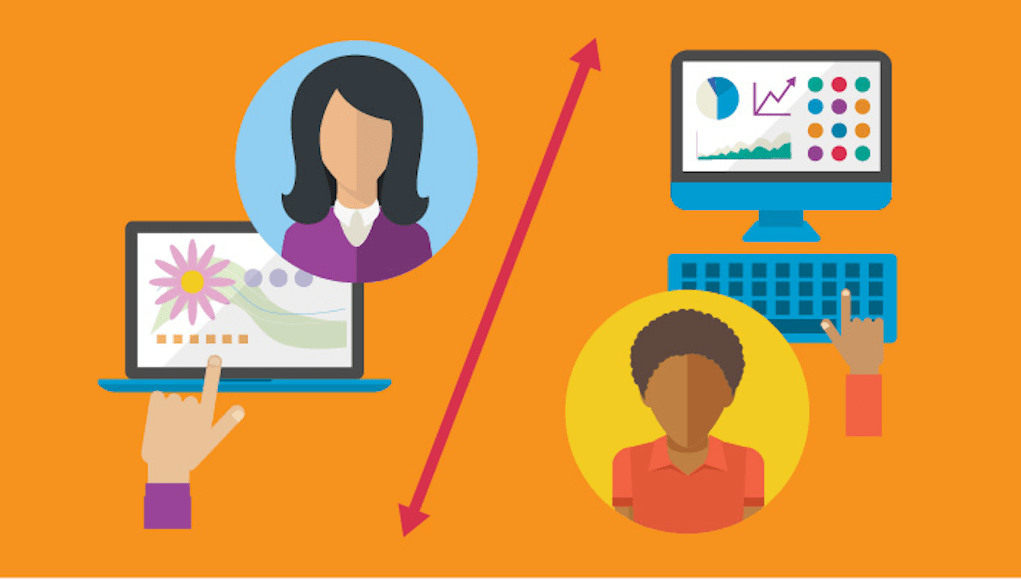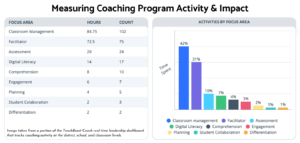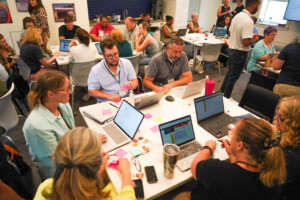What Makes an Effective Classroom Coaching Program?

By: Jessica Schuler, Mahsa Bakhshaei and Angela Hardy
Coaches may be most often associated with the fields of athletics or business, but they are just as important in education. Coaches in any realm have the same goal—to improve performance and assist those they coach in reaching their full potential. In the school setting, coaches provide one-on-one support to help teachers tackle classroom challenges and identify strategies that best support their practices as well as student achievement.
The Dynamic Learning Project (DLP), a national program developed in partnership with Digital Promise, Google and EdTechTeam, is a classroom-based coaching program that helps schools leverage technology in impactful ways to support teacher professional growth and improve student engagement and learning.
During its first year, we identified the core attributes of an effective coaching program. Building on these findings, as the program doubled in size to nearly 2,000 coached teachers in year two, we determined five cornerstone components that account for much of this success.
It’s a Partnership
When positioned as a partnership between the principal, coach, and teachers, classroom coaching is more likely to be successful in creating change in teacher practice. And these partnerships are most successful when participation in coaching is voluntary and non-evaluative for teachers.
During the first two years of the Dynamic Learning Project, nearly all coached teachers—94 %—participated willingly. When teachers volunteered for coaching, they were more likely to take ownership of the process, which in turn led to greater improvement in addressing their classroom challenges.
Teachers are more willing to volunteer to be coached when administrators and coaches create a safe environment where teachers feel comfortable trying new practices without fear of judgment. This non-evaluative relationship encourages open collaboration and results in greater progress in meaningful technology use in the classroom.
The collaboration between the coach and the teacher helps teachers take risks and strengthen their own processes for learning and innovation. As the year progressed and the DLP teacher/coach relationship grew stronger, teachers became increasingly more comfortable taking the lead in initiating ideas and determining next steps.
While collaboration is important, it is also critical that the teacher drives the direction. “She’s not telling [me] what to do; she’s just helping me with what I want to do,” said one participating high school math teacher. Another said: “A good coach is somebody who’s there to give you guidance while also giving you autonomy.”
The principal also plays a crucial role in the partnership by demonstrating their support of the coaching program and building buy-in throughout the school building. The principal also empowers the coach to build the program based on the context of the school.
“The principal needs to be the biggest cheerleader for the program and support teachers when they are unsure of themselves and the risks that they will be taking,” said one DLP principal.
It Promotes Active Learning
The Dynamic Learning Project provides opportunities for teachers to engage in active learning that is relevant to their classroom through different types of meetings with the coach, from one-on-one formal and informal meetings, to classroom visits from the coach, to co-teaching and modeling, to coach-facilitated group professional development (PD). Through these various engagements, teachers feel the coach helps them apply new strategies into their practice in a way that goes beyond what traditional PD can provide.
“[I have] been able with [my coach] to get down to the nitty-gritty, the little tiny details that you usually don’t have time for in regular PD,” said an eighth-grade English/language arts teacher. “With lots of other PDs, I’m not able to use what I’ve learned … With [my coach], it was immediate application, which was wonderful.”
It’s Personalized
DLP coaches adapt their support to each teacher’s individual classroom challenges and tailor their pacing, approach, suggestions and type of support to meet each teacher’s unique needs. When teachers are able to implement strategies and tools that are directly relevant to their practice, the immediate benefit to their classroom builds deeper trust in the teacher/coach relationship.
“We all need different things and we all struggle with different things, so I think it’s great that it works on what I need personally in my setting,” said a sixth-grade science teacher.
It’s Sustained
Consistent support over the course of the DLP’s eight-week coaching cycle allows sufficient time for experimentation and relationship building, increasing the comfort level between the teacher and the coach. Sustained coaching also allows the coach to become more familiar with the teacher, allowing for more tailored support and creating opportunities for more sustainable change in practice.
In the DLP’s second year, participating teachers received, on average, more than 16 hours of coaching support over the course of the school year. Teachers who received more hours of coaching were more likely to see improvement in their professional growth.
Unlike episodic professional development sessions, sustained coaching allows teachers time to brainstorm new ideas, experiment, and reflect. Moreover, the continuous coaching sessions allow the coach to learn each teacher’s style and attitude so that they can understand how much and in what ways to push them.
It’s Content-Flexible
DLP coaches work with teachers in using technology to support whatever content is being taught. In this partnership, it is the teacher that brings the expertise and experience in a specific subject. However, the vast majority of DLP teachers—93 %—agreed that their coaches had the knowledge they needed to help them leverage technology to teach their content areas, even if they were not experts in the subject, and 85 % of coaches did not find it a challenge to coach outside their own area of expertise.
“Often technology coaches do not consider fine arts when thinking of professional development that is relevant,” said a middle school art teacher. “Our DLP coach was phenomenal at working with me, finding relevant technology to use in the classroom, and taking the time to come to my classroom to work with the students and me during this process.”
Moreover, some coaches found that not being an expert in a teacher’s content area could be a strength, as it lends an outside perspective and an opportunity for the teacher to consider different approaches.
“I think sometimes a viewpoint from someone not familiar with a topic can help teachers avoid assumptions or identify areas where students may also have misconceptions or issues,” said one DLP coach.
Effective Classroom Coaching Programs Focus on Teachers
Participating teachers reported that DLP coaching provided more meaningful professional development experiences than other types of PD. Providing personalized and consistent coaching in partnership with teachers and giving them safe spaces to experiment all contribute to effective classroom coaching programs.
“Teachers’ days are long and stressful, even without adding in the time and energy needed to research current practices,” said a middle school foreign language teacher. “The coach is the bridge to effective practices in research and the introduction and adoption of those practices in the classroom.”
The Dynamic Learning Project is now officially open to all interested schools. To learn more, visit dynamiclearningproject.com, and fill out the interest form.
For more, see:
- Professional Development: What Do Educators Really Need?
- Micro-Grants for Transformative Professional Development
- What Can Student Learning Teach Us About Professional Development for Teachers?
Stay in-the-know with innovations in learning by signing up for the weekly Smart Update. This post includes mentions of a Getting Smart partner. For a full list of partners, affiliate organizations and all other disclosures, please see our Partner page.
Jessica Schuler is the Senior Communications Manager for Digital Promise.
Mahsa Bakhshaei is the Lead Research Scientist for The Dynamic Learning Project at Digital Promise.
Angela Hardy is a Research Analyst for the Dynamic Learning Project at Digital Promise.
This blog was originally published on Digital Promise.




0 Comments
Leave a Comment
Your email address will not be published. All fields are required.